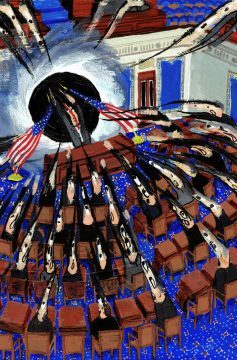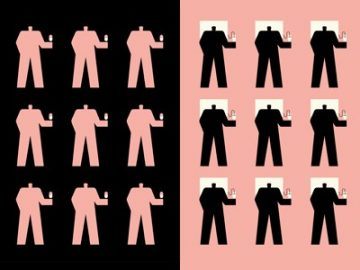Ed Vulliamy at Lit Hub:
 B.B. King, Indianola, Mississippi, 2013—The fat red sun settled against the horizon, throwing a last honey-sweet light across the humid evening and over a small crowd on the lawn beside a railroad track that cut through the cotton fields beyond. A quarter-moon was rising and a chorus of cicadas serenaded the imminent twilight, now joined by the sound of the band; the drummer caught the backbeat and the compere announced: “How about an Indianola hometown welcome for the one and only King of the Blues—B.B. King!”
B.B. King, Indianola, Mississippi, 2013—The fat red sun settled against the horizon, throwing a last honey-sweet light across the humid evening and over a small crowd on the lawn beside a railroad track that cut through the cotton fields beyond. A quarter-moon was rising and a chorus of cicadas serenaded the imminent twilight, now joined by the sound of the band; the drummer caught the backbeat and the compere announced: “How about an Indianola hometown welcome for the one and only King of the Blues—B.B. King!”
And on he came, to applause from people who knew him well and claim him as their own—last of the blues masters, a few weeks short of his 87th birthday. “Nice evening, isn’t it?” he said, and introduced his nephew on sax. Some of his 15 children (all by different mothers) and innumerable grandchildren were in the audience, though one of his daughters had died recently of diabetes, giving added poignancy to the occasion.
more here.

 A novel tells you far more about a writer than an essay, a poem, or even an autobiography,” says Martin Amis. He then adds, “My father thought this, too.” This statement is especially intriguing in light of his soon-to-be-published book,
A novel tells you far more about a writer than an essay, a poem, or even an autobiography,” says Martin Amis. He then adds, “My father thought this, too.” This statement is especially intriguing in light of his soon-to-be-published book,  Four days before ordering a drone strike against the Iranian military commander Qassem Suleimani, Donald Trump was debating the assassination on his own Florida golf course, according to Bob Woodward’s new book on the mercurial president.
Four days before ordering a drone strike against the Iranian military commander Qassem Suleimani, Donald Trump was debating the assassination on his own Florida golf course, according to Bob Woodward’s new book on the mercurial president.  When the human genome was sequenced almost 20 years ago, many researchers were confident they’d be able to quickly home in on the genes responsible for complex diseases such as diabetes or schizophrenia. But they stalled fast, stymied in part by their ignorance of the system of switches that govern where and how genes are expressed in the body. Such gene regulation is what makes a heart cell distinct from a brain cell, for example, and distinguishes tumors from healthy tissue. Now, a massive, decadelong effort has begun to fill in the picture by linking the activity levels of the 20,000 protein-coding human genes, as shown by levels of their RNA, to variations in millions of stretches of regulatory DNA.
When the human genome was sequenced almost 20 years ago, many researchers were confident they’d be able to quickly home in on the genes responsible for complex diseases such as diabetes or schizophrenia. But they stalled fast, stymied in part by their ignorance of the system of switches that govern where and how genes are expressed in the body. Such gene regulation is what makes a heart cell distinct from a brain cell, for example, and distinguishes tumors from healthy tissue. Now, a massive, decadelong effort has begun to fill in the picture by linking the activity levels of the 20,000 protein-coding human genes, as shown by levels of their RNA, to variations in millions of stretches of regulatory DNA. Being untainted by the Ivy League credentials of his predecessors may enable Mr. Biden to connect more readily with the blue-collar workers the Democratic Party has struggled to attract in recent years. More important, this aspect of his candidacy should prompt us to reconsider the meritocratic political project that has come to define contemporary liberalism.
Being untainted by the Ivy League credentials of his predecessors may enable Mr. Biden to connect more readily with the blue-collar workers the Democratic Party has struggled to attract in recent years. More important, this aspect of his candidacy should prompt us to reconsider the meritocratic political project that has come to define contemporary liberalism. Many Americans trusted intuition to help guide them through this disaster. They grabbed onto whatever solution was most prominent in the moment, and bounced from one (often false) hope to the next. They saw the actions that individual people were taking, and blamed and shamed their neighbors. They lapsed into magical thinking, and believed that the world would return to normal within months. Following these impulses was simpler than navigating a web of solutions, staring down broken systems, and accepting that the pandemic would rage for at least a year.
Many Americans trusted intuition to help guide them through this disaster. They grabbed onto whatever solution was most prominent in the moment, and bounced from one (often false) hope to the next. They saw the actions that individual people were taking, and blamed and shamed their neighbors. They lapsed into magical thinking, and believed that the world would return to normal within months. Following these impulses was simpler than navigating a web of solutions, staring down broken systems, and accepting that the pandemic would rage for at least a year. Before the young in this country ever stop racism, much less enact socialism, they better start by changing our form of government. Thanks to the U.S. Senate, the government still overrepresents the racist and populist parts of the country. It also now overrepresents the rural areas or underpopulated interior regions that are the biggest losers in the global economy—and by no coincidence, it has made easier the rise of Trump. Even if Republican senators from these states are by and large more genteel than the Republican members of the U.S. House, they are the real screamers, who give voice to the country’s id, or rather the parts that are most raw and red and racist.
Before the young in this country ever stop racism, much less enact socialism, they better start by changing our form of government. Thanks to the U.S. Senate, the government still overrepresents the racist and populist parts of the country. It also now overrepresents the rural areas or underpopulated interior regions that are the biggest losers in the global economy—and by no coincidence, it has made easier the rise of Trump. Even if Republican senators from these states are by and large more genteel than the Republican members of the U.S. House, they are the real screamers, who give voice to the country’s id, or rather the parts that are most raw and red and racist. Early on it was commonly said that we were all in the same boat, and in fact I recall, in the early days, a unifying sensation that was not unpleasant: the slam and bolt of a nation battening down the hatches. Eighty years and a day before we entered national quarantine, Virginia Woolf had recalled a “sudden profuse shower just before the war which made me think of all men and women weeping”. There is consolation in a common grief. But it is not the same boat: it is the same storm, and different vessels weather it. It would require a wilful dereliction of the intellect to believe that the risk to a Black woman managing a hospital ward is equal to the risk to – let’s say – a columnist deploring the brief and slight curtailment of her liberty.
Early on it was commonly said that we were all in the same boat, and in fact I recall, in the early days, a unifying sensation that was not unpleasant: the slam and bolt of a nation battening down the hatches. Eighty years and a day before we entered national quarantine, Virginia Woolf had recalled a “sudden profuse shower just before the war which made me think of all men and women weeping”. There is consolation in a common grief. But it is not the same boat: it is the same storm, and different vessels weather it. It would require a wilful dereliction of the intellect to believe that the risk to a Black woman managing a hospital ward is equal to the risk to – let’s say – a columnist deploring the brief and slight curtailment of her liberty. To define integrity at the FDA a decade ago, I turned to the agency’s chief scientist, top lawyer and leading policy official. They set out three criteria (see
To define integrity at the FDA a decade ago, I turned to the agency’s chief scientist, top lawyer and leading policy official. They set out three criteria (see  One single unending sentence, Eden Eden Eden is a headlong dive into zones stricken with violence, degradation, and ecstasy. Liquids, solids, ethers and atoms build the text, constructing a primacy of sensation: hay, grease, oil, gas, ozone, date-sugar, dates, shit, saliva, camel-dung, mud, cologne, wine, resin, baby droppings, leather, tea, coral, juice, dust, saltpetre, perfume, bile, blood, gonacrine, spit, sweat, sand, urine, grains, pollen, mica, gypsum, soot, butter, cloves, sugar, paste, potash, burnt-food, insecticide, black gravy, fermenting bellies, milk spurting blue… are but some of the materials that litter the Algerian desert at war—a landscape that bleeds, sweats, mutates, and multiplies. As the corporeal is rendered material and vice-versa, moral, philosophical and political categories are suspended or evacuated to give way to a new Word, stripped of both representation and ideology. The debris of this imploded terrain is left to be consumed—masticated, ingested, defecated, ejaculated. This fixation on substances is pushed through the antechambers of sunstroke lust and into wider space: “boy, shaken by coughing-fit, stroking eyes warmed by fire filtered through stratosphere [ … ] engorged glow of rosy fire bathing mouths, filtered through transparent membranes of torn lungs—of youth, bathing sweaty face” (pp.148-149).
One single unending sentence, Eden Eden Eden is a headlong dive into zones stricken with violence, degradation, and ecstasy. Liquids, solids, ethers and atoms build the text, constructing a primacy of sensation: hay, grease, oil, gas, ozone, date-sugar, dates, shit, saliva, camel-dung, mud, cologne, wine, resin, baby droppings, leather, tea, coral, juice, dust, saltpetre, perfume, bile, blood, gonacrine, spit, sweat, sand, urine, grains, pollen, mica, gypsum, soot, butter, cloves, sugar, paste, potash, burnt-food, insecticide, black gravy, fermenting bellies, milk spurting blue… are but some of the materials that litter the Algerian desert at war—a landscape that bleeds, sweats, mutates, and multiplies. As the corporeal is rendered material and vice-versa, moral, philosophical and political categories are suspended or evacuated to give way to a new Word, stripped of both representation and ideology. The debris of this imploded terrain is left to be consumed—masticated, ingested, defecated, ejaculated. This fixation on substances is pushed through the antechambers of sunstroke lust and into wider space: “boy, shaken by coughing-fit, stroking eyes warmed by fire filtered through stratosphere [ … ] engorged glow of rosy fire bathing mouths, filtered through transparent membranes of torn lungs—of youth, bathing sweaty face” (pp.148-149). Now fifty-eight, Rist has the energy and curiosity of an ageless child. “She’s individual and unforgettable,” the critic Jacqueline Burckhardt, one of Rist’s close friends, told me. “And she has developed a completely new video language that warms this cool medium up.” Burckhardt and her business partner, Bice Curiger, documented Rist’s career in the international art magazine Parkett, which they co-founded with others in Zurich in 1984. From the single-channel videos that Rist started making in the eighties, when she was still in college, to the immersive, multichannel installations that she creates today, she has done more to expand the video medium than any artist since the Korean-born visionary Nam June Paik. Rist once wrote that she wanted her video work to be like women’s handbags, with “room in them for everything: painting, technology, language, music, lousy flowing pictures, poetry, commotion, premonitions of death, sex, and friendliness.” If Paik is the founding father of video as an art form, Rist is the disciple who has done the most to bring it into the mainstream of contemporary art.
Now fifty-eight, Rist has the energy and curiosity of an ageless child. “She’s individual and unforgettable,” the critic Jacqueline Burckhardt, one of Rist’s close friends, told me. “And she has developed a completely new video language that warms this cool medium up.” Burckhardt and her business partner, Bice Curiger, documented Rist’s career in the international art magazine Parkett, which they co-founded with others in Zurich in 1984. From the single-channel videos that Rist started making in the eighties, when she was still in college, to the immersive, multichannel installations that she creates today, she has done more to expand the video medium than any artist since the Korean-born visionary Nam June Paik. Rist once wrote that she wanted her video work to be like women’s handbags, with “room in them for everything: painting, technology, language, music, lousy flowing pictures, poetry, commotion, premonitions of death, sex, and friendliness.” If Paik is the founding father of video as an art form, Rist is the disciple who has done the most to bring it into the mainstream of contemporary art. The internet is not what you think it is. For one thing, it is not nearly as newfangled as you probably imagine. It does not represent a radical rupture with everything that came before, either in human history or in the vastly longer history of nature that precedes the first appearance of our species. It is, rather, only the most recent permutation of a complex of behaviors as deeply rooted in who we are as a species as anything else we do: our storytelling, our fashions, our friendships; our evolution as beings that inhabit a universe dense with symbols.
The internet is not what you think it is. For one thing, it is not nearly as newfangled as you probably imagine. It does not represent a radical rupture with everything that came before, either in human history or in the vastly longer history of nature that precedes the first appearance of our species. It is, rather, only the most recent permutation of a complex of behaviors as deeply rooted in who we are as a species as anything else we do: our storytelling, our fashions, our friendships; our evolution as beings that inhabit a universe dense with symbols.
 We know that human societies require scapegoats to blame for the calamities that befall them.[1] Scapegoats are made responsible not only for the wrong-doing of others but for the wrongs that could not possibly be attributed to any other.
We know that human societies require scapegoats to blame for the calamities that befall them.[1] Scapegoats are made responsible not only for the wrong-doing of others but for the wrongs that could not possibly be attributed to any other.